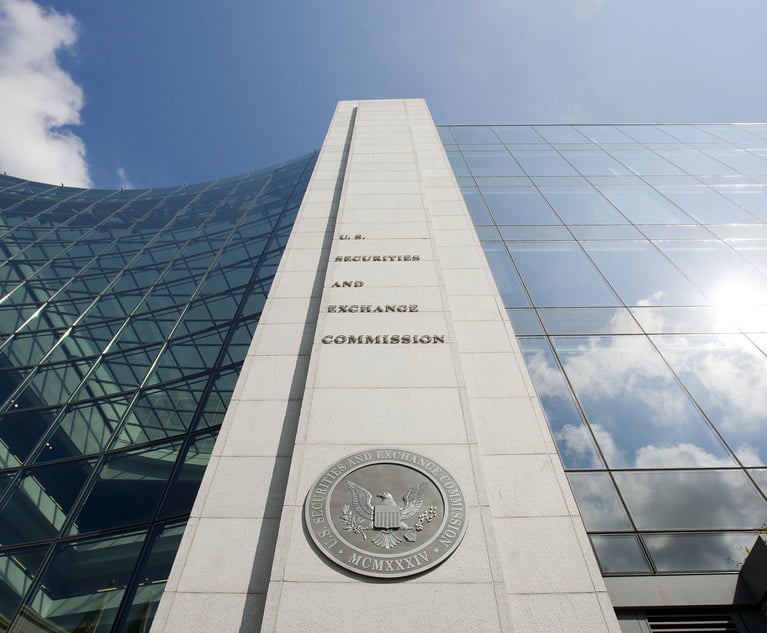A model of (in)efficiency in NPE litigation
While aggressive legal defense against NPE assertion is at times warranted and indeed necessary, it is far more efficient for those 40 defendants to work together to proactively buy the patent from the owner before litigation occurs.
January 26, 2014 at 07:00 PM
4 minute read
In-house counsel have long known that non-practicing entity (NPE) litigation is expensive, and we've always believed that the process is maddeningly wasteful and inefficient. Exactly how expensive and inefficient, however, has been difficult to pinpoint because there's been an utter lack of data and no accurate way to quantify the waste of NPE assertions in dollar terms.
Until now.
As I've discussed in previous columns, RPX has been building a growing database covering patent transactions and activity, including a broad cross-section of detailed litigation cost information. The data shows, across thousands of cases, how defense counsel, plaintiff counsel, NPEs and patent owners capture the costs of NPE litigation. Using this information, I'll give a simple illustration to show just where the money is going in a typical NPE litigation.
In this example—which, by the way, is closely based on a monetization campaign outlined in an offering memorandum by a fund-raising NPE—the portfolio would be monetized on a contingency basis, meaning the owner of the patents would receive payment only after costs were taken out of the settlement. The portfolio was thought to have broad applicability and the NPE had targeted 40 operating companies as alleged infringers.
The average settlement in the campaign was expected to be $1 million per defendant company, producing $40 million in revenue (the bottom half of the bar chart) and we know from RPX data that on average, each company would also spend an average of $1 million to defend against the suit, producing $40 million in total legal costs (the top half of the bar).
Already this looks like a very inefficient way to transfer economic value, as the legal transaction costs are equal to the license value of the asset. In truth, it is even more economically irrational than this because the settlement itself is reduced by further transaction costs on the plaintiff's side.
In this example, $32 million of the $40 million settlement was expected to be spent on various plaintiff's counsel, experts and legal support, or delivered to the NPE and its investors. After these costs, there would only be a net of $8 million remaining for the owner of the portfolio.
In other words, to generate an $8 million payment for the inventor/owner of the patent, this campaign would incur a total of $72 million in frictional costs—a roughly 900 percent transaction cost. This is quantifiable waste on a monumental scale, and it proves that the intuition of in-house counsel has been entirely accurate.
The central problem, of course, is the inherent high cost and inefficiency of the legal system. In a functioning market ecosystem, the payment from the “users” of the patent to the owner would have far fewer intermediaries (who charge far less per hour) and a much more transparent form of price discovery than legal due diligence and court proceedings. There would be comparables, ready access to data, and values would more accurately reflect the value of the invention rather than the hold-up costs of litigation.
For general counsel balancing their legal and fiduciary responsibilities as corporate officers, the answer is clear. While aggressive legal defense against NPE assertion is at times warranted and indeed necessary, it is far more efficient for those 40 defendants to work together to proactively buy the patent from the owner before litigation occurs. Rather than pay $2 million each, those 40 defendants could have paid $200,000 each and provided the same return to the patent owner. In other words, head off the problem before it starts and before those 900 percent transaction costs artificially inflate the amount paid by the defendants for the asset.
This content has been archived. It is available through our partners, LexisNexis® and Bloomberg Law.
To view this content, please continue to their sites.
Not a Lexis Subscriber?
Subscribe Now
Not a Bloomberg Law Subscriber?
Subscribe Now
NOT FOR REPRINT
© 2025 ALM Global, LLC, All Rights Reserved. Request academic re-use from www.copyright.com. All other uses, submit a request to [email protected]. For more information visit Asset & Logo Licensing.
You Might Like
View All
Antitrust in Trump 2.0: Expect Gap Filling from State Attorneys General
6 minute read

From Reluctant Lawyer to Legal Trailblazer: Agiloft's GC on Redefining In-House Counsel With Innovation and Tech
7 minute read
Ad Agency Legal Chief Scores $12M Golden Parachute in $13B Sale to Rival
3 minute readTrending Stories
- 1‘The Decision Will Help Others’: NJ Supreme Court Reverses Appellate Div. in OPRA Claim Over Body-Worn Camera Footage
- 2MoFo Associate Sees a Familiar Face During Her First Appellate Argument: Justice Breyer
- 3Antitrust in Trump 2.0: Expect Gap Filling from State Attorneys General
- 4People in the News—Jan. 22, 2025—Knox McLaughlin, Saxton & Stump
- 5How I Made Office Managing Partner: 'Be Open to Opportunities, Ready to Seize Them When They Arise,' Says Lara Shortz of Michelman & Robinson
Who Got The Work
J. Brugh Lower of Gibbons has entered an appearance for industrial equipment supplier Devco Corporation in a pending trademark infringement lawsuit. The suit, accusing the defendant of selling knock-off Graco products, was filed Dec. 18 in New Jersey District Court by Rivkin Radler on behalf of Graco Inc. and Graco Minnesota. The case, assigned to U.S. District Judge Zahid N. Quraishi, is 3:24-cv-11294, Graco Inc. et al v. Devco Corporation.
Who Got The Work
Rebecca Maller-Stein and Kent A. Yalowitz of Arnold & Porter Kaye Scholer have entered their appearances for Hanaco Venture Capital and its executives, Lior Prosor and David Frankel, in a pending securities lawsuit. The action, filed on Dec. 24 in New York Southern District Court by Zell, Aron & Co. on behalf of Goldeneye Advisors, accuses the defendants of negligently and fraudulently managing the plaintiff's $1 million investment. The case, assigned to U.S. District Judge Vernon S. Broderick, is 1:24-cv-09918, Goldeneye Advisors, LLC v. Hanaco Venture Capital, Ltd. et al.
Who Got The Work
Attorneys from A&O Shearman has stepped in as defense counsel for Toronto-Dominion Bank and other defendants in a pending securities class action. The suit, filed Dec. 11 in New York Southern District Court by Bleichmar Fonti & Auld, accuses the defendants of concealing the bank's 'pervasive' deficiencies in regards to its compliance with the Bank Secrecy Act and the quality of its anti-money laundering controls. The case, assigned to U.S. District Judge Arun Subramanian, is 1:24-cv-09445, Gonzalez v. The Toronto-Dominion Bank et al.
Who Got The Work
Crown Castle International, a Pennsylvania company providing shared communications infrastructure, has turned to Luke D. Wolf of Gordon Rees Scully Mansukhani to fend off a pending breach-of-contract lawsuit. The court action, filed Nov. 25 in Michigan Eastern District Court by Hooper Hathaway PC on behalf of The Town Residences LLC, accuses Crown Castle of failing to transfer approximately $30,000 in utility payments from T-Mobile in breach of a roof-top lease and assignment agreement. The case, assigned to U.S. District Judge Susan K. Declercq, is 2:24-cv-13131, The Town Residences LLC v. T-Mobile US, Inc. et al.
Who Got The Work
Wilfred P. Coronato and Daniel M. Schwartz of McCarter & English have stepped in as defense counsel to Electrolux Home Products Inc. in a pending product liability lawsuit. The court action, filed Nov. 26 in New York Eastern District Court by Poulos Lopiccolo PC and Nagel Rice LLP on behalf of David Stern, alleges that the defendant's refrigerators’ drawers and shelving repeatedly break and fall apart within months after purchase. The case, assigned to U.S. District Judge Joan M. Azrack, is 2:24-cv-08204, Stern v. Electrolux Home Products, Inc.
Featured Firms
Law Offices of Gary Martin Hays & Associates, P.C.
(470) 294-1674
Law Offices of Mark E. Salomone
(857) 444-6468
Smith & Hassler
(713) 739-1250






